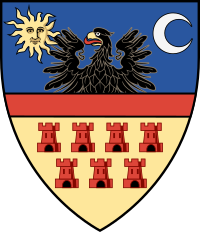Our website is made possible by displaying online advertisements to our visitors.
Please consider supporting us by disabling your ad blocker.
Flag and coat of arms of Transylvania
| Coat of arms of Transylvania | |
|---|---|
 | |
| Armiger | Grand Principality of Transylvania |
| Adopted | November 2, 1765 |
| Shield | Per fess Azure and Or, a fess Gules between in chief an eagle issuant from the division Sable flanked by a sun-in-splendour Or and an increscent Argent, and in base seven towers Gules. |
| Earlier version(s) | Transylvanian Principality (after ca. 1580) |
| Use | No current official status |
The flag and coat of arms of Transylvania were granted by Maria Theresa in 1765, when she established a Grand Principality within the Habsburg monarchy. While neither symbol has official status in present-day Romania, the coat of arms is marshalled within the national Romanian arms; it was also for decades a component of the Hungarian arms. In its upper half, it prominently includes the eagle, which may have been one of the oldest regional symbols, or is otherwise a localized version of the Polish eagle. Early versions of the Transylvanian charges were first designed in Habsburg Hungary at some point before 1550, and were therefore symbols of pretence.
The arms were only attested as in use by the Transylvanian Principality in or after 1580. The first Prince to recognize and use them was Sigismund Báthory, who also simplified the charges. They entered the heraldic patrimony over the next few decades, and, during Ákos Barcsay's reign, were codified as representing three separate jurisdictions: the eagle stood for Transylvania-proper, the sun-and-crescent is for Székely Land (as in the coat of arms of the Székelys), while the seven towers are canting arms of the Saxon-populated cities. They are also widely understood as ethnic symbols of the three privileged nations (therefore excluding Romanians), but this interpretation is criticized as inaccurate by various historians.
Before Maria Theresa, Transylvania's rulers used a variety of flags, which more often than not included family or factional symbols, such as the Báthory "wolf teeth"; Prince Sigismund also used a prototype of the Hungarian tricolor, but the practice died out long before the Habsburg conquest. Transylvania's Habsburg tricolor and the flag of Romania resemble each other superficially: Transylvania has blue-red-yellow displayed horizontally, while Romania has blue-yellow-red, vertically. The Transylvanian colors were codified from the heraldic tinctures, but Romanian scholars such as Iosif Sterca-Șuluțiu ascribe them a Dacian origin and links to the Romanian ethnogenesis. They became popular among the Romanian community of Transylvania in the later stages of the 1848 Revolution, after replacing combinations of blue, red and white.
On such grounds, Transylvanian flags were often used in Austria-Hungary to camouflage celebrations of Romanian nationalism, and as such contributed to a simmering Hungarian–Romanian conflict before and during World War I. In this context, references to the "Transylvanian tricolor" often referred to a blue-yellow-red horizontal variation. Saxon organizations have traditionally reduced the tricolor to a blue-over-red or red-over-blue arrangement, which was also disliked by Hungarian authorities. Both sets of flags were flown by communities supporting the 1918 union with Romania; in its aftermath, Transylvanian or Tranylvanian-derived symbols were sometimes used by Hungarians seeking autonomy for the region as a whole. In parallel, pro-autonomy activists in Székely Land have adopted a blue-gold-silver pattern.
Previous Page Next Page


